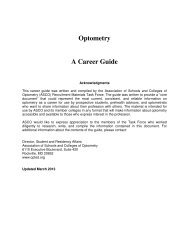Summer 2012, Volume 37, Number 3 - Association of Schools and ...
Summer 2012, Volume 37, Number 3 - Association of Schools and ...
Summer 2012, Volume 37, Number 3 - Association of Schools and ...
You also want an ePaper? Increase the reach of your titles
YUMPU automatically turns print PDFs into web optimized ePapers that Google loves.
Although the disorder can occur in<br />
children <strong>and</strong> men, it most frequently<br />
occurs in women age 20-50 who are<br />
overweight. 1 Several studies have demonstrated<br />
that African American patients<br />
<strong>and</strong> men with the condition have<br />
a more aggressive form <strong>of</strong> the disease<br />
<strong>and</strong> require more aggressive intervention.<br />
7 The incidence <strong>of</strong> this condition<br />
per year is 0.9 per 100,000 people in the<br />
general population <strong>and</strong> 3.5 per 100,000<br />
in women 15-44 years <strong>of</strong> age. 1<br />
Cerebrospinal fluid, optic nerve: basic<br />
review<br />
The brain, its blood supply <strong>and</strong> the<br />
CSF are maintained within the skull.<br />
Because the skull is made <strong>of</strong> bone <strong>and</strong> is<br />
nonflexible, a delicate balance must be<br />
maintained between all the structures<br />
within the skull. CSF is a clear, colorless<br />
liquid, which is mainly produced in the<br />
choroidal plexus within the ventricular<br />
system <strong>of</strong> the brain. 8 CSF resides in the<br />
space between the arachnoid mater <strong>and</strong><br />
the pia mater, the subarachnoid space. 8<br />
The CSF provides nutrients, aids in<br />
waste removal, maintains chemical stability<br />
<strong>and</strong> cushions the brain. 8 The CSF<br />
is produced at a rate <strong>of</strong> half a liter per<br />
day <strong>and</strong> is turned over several times<br />
per day. 8 A steady state must be maintained<br />
between production <strong>and</strong> drainage<br />
<strong>of</strong> CSF to maintain an appropriate<br />
amount <strong>of</strong> fluid within the skull.<br />
The CSF circulates from the site <strong>of</strong> formation<br />
to the subarachnoid space <strong>and</strong><br />
interpeduncular <strong>and</strong> quadrigeminal<br />
cisterns. 9 Drainage <strong>of</strong> fluid involves absorption<br />
into the venous system, which<br />
occurs mainly through the arachnoid<br />
villi in the brain <strong>and</strong> the arachnoid<br />
granulations. 9 This occurs via two pathways:<br />
active transport through the cells<br />
<strong>of</strong> the arachnoid granulations into the<br />
dural venous sinus or transport between<br />
the cells <strong>of</strong> the arachnoid granulations. 9<br />
CSF absorption can also occur through<br />
the extracranial lymphatic system. 1<br />
The optic nerve is considered part <strong>of</strong><br />
the central nervous system. 10 Retinal<br />
ganglion cells exit the eye at the lamina<br />
cribrosa <strong>and</strong> acquire a myelin sheath to<br />
form the optic nerve. 10 The optic nerve<br />
sheath is comprised <strong>of</strong> fibrous tissue<br />
<strong>and</strong> has a limited ability to exp<strong>and</strong>. 11<br />
The optic nerve <strong>and</strong> fibrous tissue run<br />
within the subarachnoid space. 11<br />
The subarachnoid space around the optic<br />
nerve communicates with the subarachnoid<br />
spaces around other parts <strong>of</strong><br />
the brain. 10 The formation <strong>of</strong> optic nerve<br />
edema depends on the interaction <strong>of</strong><br />
CSF pressure, intraocular pressure <strong>and</strong><br />
systemic blood pressure. 11 An increase<br />
in CSF pressure from overproduction,<br />
underabsorption or any obstruction <strong>of</strong><br />
CSF combined with low intraocular<br />
pressure or low perfusion pressure can<br />
result in optic nerve edema. 1 Increased<br />
intracranial pressure <strong>and</strong> resulting optic<br />
nerve edema damage the optic nerve by<br />
disruption <strong>of</strong> axonal transport, intraneuronal<br />
ischemia or a combination <strong>of</strong><br />
both. 1<br />
There are several hypotheses <strong>of</strong> mechanisms<br />
for the increase in intracranial<br />
pressure in IIH. They include increased<br />
brain water content, increased CSF<br />
production, reduced CSF drainage, increased<br />
cerebral venous pressure <strong>and</strong>,<br />
more recently, connections between<br />
CSF space <strong>and</strong> the nasal lymphatic system.<br />
5 The most supported hypothesis<br />
for increased pressure is reduced CSF<br />
absorption. 1 Reduced absorption may<br />
be secondary to dysfunction <strong>of</strong> the absorptive<br />
mechanism <strong>of</strong> the arachnoid<br />
granulations or through the extracranial<br />
lymphatics. 12<br />
Clinical features<br />
Common clinical features <strong>of</strong> IIH are:<br />
• Headaches<br />
Ninety to 94% <strong>of</strong> patients with IIH<br />
present with headaches. 13-17 The headaches<br />
are described by patients as severe,<br />
“the worst headache <strong>of</strong> my life.” 1<br />
The pain is generalized, pulsatile, may<br />
awaken the patient from sleep, usually<br />
lasts for hours <strong>and</strong> is worse in the<br />
morning. 18 Occasionally patients report<br />
neck, back or shoulder pain. 18 The<br />
headache may be associated with nausea<br />
<strong>and</strong> vomiting, with vomiting being<br />
less common. 1<br />
• Transient visual disturbances<br />
Transient blurred vision or other visual<br />
disturbances that usually last less than<br />
30 seconds are reported in 68% <strong>of</strong> patients.<br />
1,17 The symptoms may be monocular<br />
or binocular <strong>and</strong> are believed to<br />
be related to transient ischemia secondary<br />
to increased tissue pressure. 19<br />
• Tinnitus<br />
Intracranial pulsatile noises are reported<br />
by 58% <strong>of</strong> patients. 17 These noises can<br />
vary in description, intensity <strong>and</strong> duration.<br />
2 The noises have been described<br />
by patients as “buzzing,” “thumping” or<br />
“heartbeat.” 17 The causes <strong>of</strong> the noises<br />
are believed to be related to the movement<br />
<strong>of</strong> CSF under high pressure. 20<br />
• Papilledema<br />
Optic disc edema caused by an increase<br />
in intracranial pressure is known as<br />
papilledema. Papilledema is the hallmark<br />
ophthalmoscopic sign <strong>of</strong> IIH. 1<br />
Stereoscopic disc viewing such as with<br />
fundus biomicroscopy is essential to<br />
avoid missing early papilledema. Absence<br />
<strong>of</strong> a previously documented venous<br />
pulse or inability to induce a venous<br />
pulse can also be a helpful sign. A<br />
useful grading scheme for papilledema<br />
was devised in 1982 by Frisen <strong>and</strong> modified<br />
in 2010 by Scott. 22 The Modified<br />
Frisen Scale grades papilledema from<br />
grade 0 (normal) to grade 5 (severe).<br />
Grade 1 is considered minimal with a<br />
C-shaped peripapillary ring <strong>of</strong> edema<br />
<strong>and</strong> nasal disc margins obscured. 22<br />
Grade 2 (low degree) is characterized<br />
by a circumferential peripapillary<br />
ring with nasal disc margin elevation<br />
<strong>and</strong> temporal disc margins obscured. 22<br />
Grade 3 (moderate) is obscuration <strong>of</strong> at<br />
least one major vessel as it passes over<br />
the disc with elevation <strong>of</strong> disc borders. 22<br />
Grade 4 (marked) is total obscuration<br />
<strong>of</strong> a vessel at its origin. 22 Grade 5 (severe)<br />
is characterized by total obscuration<br />
<strong>of</strong> all vessels both on the disc <strong>and</strong><br />
leaving the disc. 22<br />
• Vision loss<br />
The consequences <strong>of</strong> papilledema can<br />
result in vision loss. According to Corbett<br />
et al., vision loss is the main morbidity<br />
associated with IIH. 3 Visual field<br />
defects found in IIH are directly related<br />
to papilledema <strong>and</strong> are similar to<br />
visual field defects that occur in other<br />
optic neuropathies. The most common<br />
defects are enlargement <strong>of</strong> the physiological<br />
blind spot <strong>and</strong> an inferior nasal<br />
step. 1 Other possible defects include arcuate<br />
defects, generalized constriction<br />
or depression <strong>of</strong> isopters, paracentral<br />
scotoma <strong>and</strong> temporal wedge defects. 21<br />
This type <strong>of</strong> vision loss is indicative <strong>of</strong><br />
damage at the level <strong>of</strong> the optic disc<br />
rather than posterior to the disc. 1 Although<br />
there is some evidence that vision<br />
loss corresponds to the severity <strong>of</strong><br />
Optometric Education 121 <strong>Volume</strong> <strong>37</strong>, <strong>Number</strong> 3 / <strong>Summer</strong> <strong>2012</strong>

















